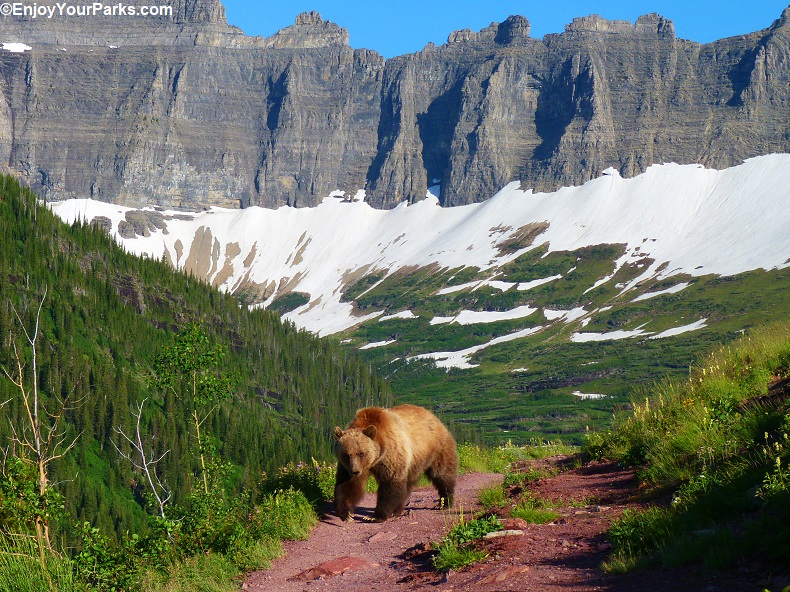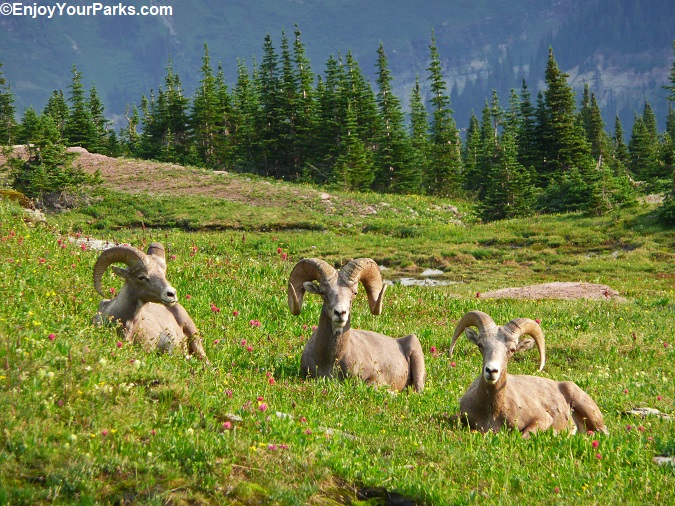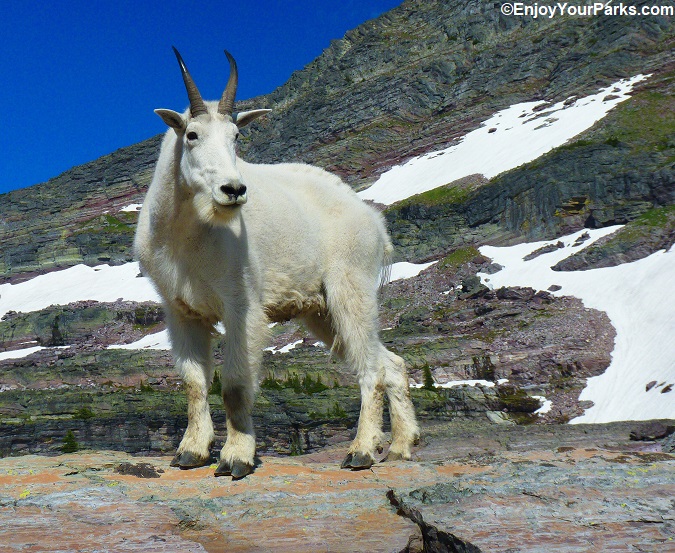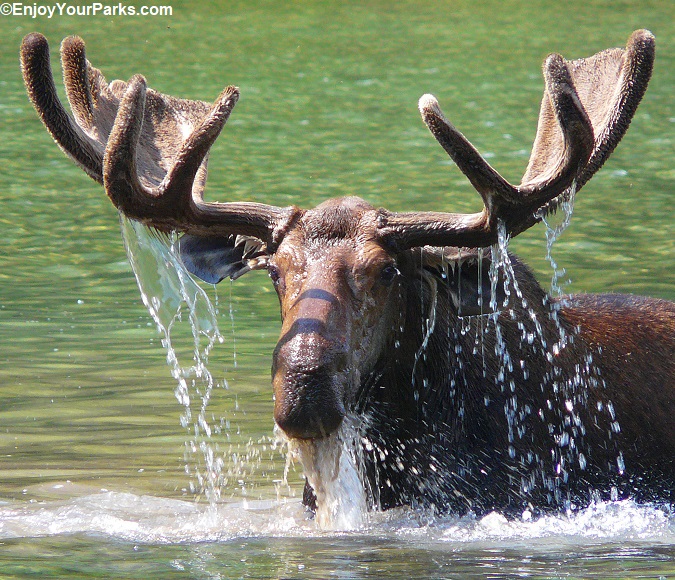Glacier Park Animals: Where To Find Them

Grizzly Bear on the Iceberg Lake Trail.
Glacier Park Animals: Where To Find Them
Glacier Park animals are plentiful and diverse. In fact, there are more species of animals found in Glacier Park than anywhere else in the Continental United States. While vacationing in Glacier Park, Glacier Park animals can be seen anywhere at any time... and any species. However, based on our many years spent in Glacier National Park, we have found there are specific locations where you have the best chances of seeing these Glacier Park animals, such as bighorn sheep, mountain goats, grizzly bears, black bears and moose. These locations are what we will share with you on this page. Of course, animals will be where they want to be, and you never know when they will appear. However, the locations we are about to share with you are where we most frequently see each of these species, which will hopefully create a better likelihood of you actually observing these amazing animals during your Glacier National Park vacation.
Glacier Park Animals: Bighorn Sheep

Glacier Park Bighorn Sheep are one of the most majestic of the Glacier Park animals. Their characteristic curled horns are always a thrill to see, and their gracefulness as they navigate the steep slopes of Glacier Park's mountains gives you an overwhelming feeling of freedom. These incredible animals can be found throughout Glacier Park, and during the summer months, they are mainly around the alpine and sub-alpine meadows such as Logan Pass along the Going To The Sun Road.
In Glacier Park, male bighorns (rams) stay away from the females (ewes) and babies (lambs) during the summer. The males hang out together in fairly large groups, with no females in sight. Sometimes you'll see up to twenty or so adult rams in one herd, which is always an awesome sight. The ewes take their lambs into alpine open meadows during the summer.
Both ewes and rams have horns, but they are not at all similar. Rams have the thick, massive, curling horns that eventually create nearly a full circle, whereas the ewes have short, thin horns that do not curl. No matter how old a ewe becomes, its horns will still remain thin and short. This is compared to an adult ram, whose horns can be 42 inches long or even longer! Sometimes the horns grow too long and they start interfering with the ram's vision, so the the ram will rub off the end of the horns, creating a "broomed" tip.
The ewe's tend to take the lambs into more remote areas, and higher on the rocky slopes. They too stick together, so it is not uncommon to see a group of 15 or more ewes with their lambs, all together in one spot. For example, we often see a large herd of ewes and lambs on the west side of the Garden Wall, just south of Iceberg Peak. This herd is about 12 miles north of Logan Pass. Whereas the males are usually hanging out right at Logan Pass. So to see bighorn lambs, you may have to hike a bit.
Bighorn sheep (both rams and ewes) migrate out of the higher elevations during the late fall, and spend their winter in less harsh areas, such as the south slope of Mount Henry and Altyn Peak just north of the Many Glacier Hotel. In the fall, you can hear loud "cracking sounds" as the males crash their horns together during the rut.
This horn crashing can be herd for miles around. It's really a spectacle to watch these huge animals crash into eachother as fast as they possibly can! And speaking of horn crashing, these two rams in the above photo were "practicing" for the rut in the Logan Pass parking lot in mid- August. We heard a loud CRACK and looked over and saw these two rams dazed after they collided!
Best Places to See a Bighorn Sheep In Glacier Park
Like we said earlier, Bighorns are found throughout Glacier Park, so whenever you are hiking you have a fairly good chance of seeing some. However, there are some areas that can almost assure that you'll see some Bighorn Sheep, and that's what we'll talk about here.
1. Logan Pass
Yes, right at Logan Pass usually has a large herd of rams that entertain visitors throughout the summer. They tend to move around quite a bit, but they are never far from the parking lot. In fact, it is quite common to have huge rams walk right through the parking lot, even during a busy day. (For more info on Logan Pass and the Going To The Sun Road, click here)
2. Hidden Lake Trail
The Hidden Lake Trail trailhead starts right behind the Visitor Center, and heads straight west for about 1.5 miles to the overlook. Usually there are Bighorns close to the trail, especially near Clements Mountain.
(For details on the Hidden Lake Overlook Trail, click here.)
3. Highline Trail
We usually see rams on the Highline Trail as well. Sometimes they are right at the head of the trail (just across the road from Logan Pass), and sometimes they're further in, maybe several miles, near Haystack Butte. (For details on the Highline Trail, click here.)
4. Iceberg Lake Trail
This trail is in the Many Glacier area, and begins at the Swiftcurrent Motor Inn. We have seen on several occasions a band of ewes and lambs on the upper slopes to your right during the first few miles of your hike. (For details on the Iceberg Lake Trail, click here.)
5. Ptarmigan Tunnel Trail
The Ptarmigan Tunnel trailhead is located at the Swiftcurrent Motor Inn in the Many Glacier Area. There is a band of ewes and lambs that hang out near the tunnel's south entrance. (For details on the Ptarmigan
Tunnel Trail, click here.)
6. Grinnell Glacier Trail
The Grinnell Glacier Trail is also located in the Many Glacier Area of Glacier Park, and the trail head is located between the Many Glacier Hotel and Swiftcurrent Motor Inn. We very often see a herd of rams near the trail along the last two miles of your hike up to the glacier. (For details on the Grinnell Glacier Trail, click here.)
We see Bighorns quite regularly when we are doing our backcountry activities. They are very plentiful in Glacier National Park, but the trick is seeing these beautiful animals on a vacation with the family where you're not spending a ton of time in the backcountry.
Even though we've mentioned several places you can see bighorn sheep with little effort, the "sure bet" is the Logan Pass Area, including the Hidden Lake Trail and the Highline Trail.
Glacier Park Animals: Black Bears

Among the favorites of Glacier Park animals, Glacier Park Black Bear come in all sorts of color phases, whether it be black, brown, tan, cinnamon, blonde, fudge, or a combination of some or all of the above. This is the most common misunderstanding that visitors have with bears. We are convinced that 99% of the time when a visitor sees a blonde colored black bear, they call it a grizzly.
Glacier Park Black bear normally do not get as large as adult grizzly bears, and are usually less temperamental. However, everyone still needs to be extremely careful around them because statistics show that even though black bear are less likely to attack a human, if an attack does happen, it's usually not a pleasant outcome. So treat these bears with the utmost respect, and stay at least one hundred yards away from them at all times.
Black Bear are easy to identify. They have long ears, a flat nose with very non-descript forehead, no obvious hump on its back, and very short claws that you can barely see. Whereas a Grizzly has short, rounded ears, a large steep forehead, an obvious hump, and really long claws that you can see from a mile away. Again, color means nothing. Grizzlies can also have many color phases.
Best Places to See a Black Bear in Glacier Park
Glacier National Park has a lot of black bears, and they can be anywhere and everywhere. They can be seen from the roads throughout the park, as well as every trail in the park. But to increase your chances for seeing a black bear, below is a list of "black bear hotspots"....
1. Swiftcurrent Motor Inn Parking Lot
This parking lot is located in the Many Glacier Area, and it's a fantastic place to view black bears, as well as grizzlies. Now the bears aren't IN the parking lot (well, most of the time anyway). Rather, they are on the huge southern slope of Mount Henkel and Altyn Peak, which are directly to the north, behind the Swiftcurrent Motor Inn.
During berry season (late July, all of August), black bear (and grizzlies) come from all around to feast on the plentiful berries on these open slopes, and you can watch them for hours with your binoculars and spotting scopes. If you don't have a spotting scope, don't worry- there are park rangers whose sole mission is to show you where the bears are with THEIR spotting scopes!
2. Just North of the Many Glacier Hotel
The southern slope of Altyn Peak is directly north of the Many Glacier Hotel, and you can literally sit on the hotel deck and see black bear and grizzlies feeding up on this huge, open slope. This slope is simply an extension of the slope above the Swiftcurrent Motor Inn, and quite often the bears will start above Swiftcurrent, and then work their way east towards the slope above the hotel. Mornings and evenings are the best time to see these bears, but we've seen them all hours of the day, especially on cooler days, so it can be a hit and miss situation. But once a bear is spotted, you'll more than likely be able to watch it for hours.
And for some reason, black bears like to eat along the south slope, and then they LOVE to cross the river just below the bridge near the Many Glacier Hotel. You would not believe how many times we've seen black bear crossing this river!
The great thing about the Many Glacier Area is that there are a fair amount of people looking for black bears and grizzlies, so when someone spots one, it becomes very obvious. The trick is to look for a large group of people all looking in the same direction and pointing in the same direction. It's more than likely either a grizzly bear or a black bear, and it's worth stopping and asking them what they are looking at.
DON'T BE SHY! If you don't get aggressive and ask, you'll miss out on some great bear watching! (And by the way, visitors LOVE to share what they are looking at with others, so get aggressive and ask!)
5. The Road Between the Many Glacier Hotel and Swiftcurrent Motor Inn
This road runs just below the huge open slope to the north between these two areas, so obviously that's where black bear and grizzlies can also be easily spotted. Again, look for a bunch of people looking up at the slope.
6. The Many Glacier Road
This is "hit and miss", but if you're timing is right, you might see a black bear along the road or near the shore of Lake Sherburne. And we have found that when the berry season isn't a really good one, and there's not many berries in this area near Lake Sherburne, the grizzlies don't show up. When this happens, we see 10 times the amount of black bear than we would normally see on a good berry year.
And here's a tip: Bears (both grizzlies and black bear) for some reason love to swim across Sherburne Lake, so keep an eye out as you are driving to or from Many Glacier. All you'll see are their heads and occasionally their shoulders, so if they are far away, you might mistake them for a duck or a goose.
4. Any Trail in the Many Glacier Area
Whether it be the Grinnell Glacier Trail, Iceberg Lake Trail, or the Swiftcurrent Pass Trail, you never know when you'll see a black bear or a grizzly. So enjoy these iconic trails, as they are some of the best hikes in North America, and keep an eye out for bears on the hillsides. There's nothing more exciting than seeing a bear on one of these trails!
5. Going-to-the-Sun Road between Rising Sun Motor Inn and the Siyeh Bend
There are some HUGE avalanche shutes to the north of the road along this stretch, and black bear and grizzlies love to hang out in them.
OBEY THE RULES!
When you see a bear, please follow the official rules and laws that the National Park Service has laid out for appropriate and safe bear viewing in Glacier. Your safety and the safety of others depends on it!
Glacier Park Animals: Mountain Goats

Another favorite among the Glacier Park animals is the Mountain Goat. Mountain Goats are an icon of Glacier National Park, and they, just like the grizzly, are true symbols of the wilderness. These beautiful animals are also some of the toughest animals in the world. They are truly at home scaling the sheer cliffs of these mountains, and they are the best mountain climbers in the world. (However, because of the treacherous landscape they hang out in, the number one cause of death for mountain goats is falling.)
Another interesting thing about mountain goats is both the male (called a billy) and female (called a nanny) have horns which almost look identical. The difference is simply that the nanny's horns are usually longer, narrower and less curved than the billy's horns.
You will also notice that their white coat looks very "mangy" during the summer. This is because they are shedding their thick winter coats from the previous winter. Then once the old coat is all rubbed off, the new coat begins to grow, usually beginning in late August.
Now even though these great Glacier Park animals thrive in the highest elevations of the park, they can also be found in sub-alpine and alpine meadows during the summer. This makes them fairly accessible to visitors, and below is a list of where you can see these "Icons of Glacier National Park" up close and personal!
Best Places to See Mountain Goats
Mountain Goats are found on nearly every mountain in the Glacier Park, so if you have binoculars, you can scan the mountain slopes above the tree line and see them scaling the cliffs. They look like white dots or tiny snow patches with the naked eye. And if you are doing a lot of hiking, especially on the passes such as Gunsight Pass, you will also see plenty of goats. HOWEVER, there are a few places where you can get reasonably close to these animals without having to hike into the backcountry, and sometimes you'll even closer than you probably want to be!
1. Hidden Lake Overlook
The Hidden Lake Overlook Trail Head is located at Logan Pass Visitors Center, and the actual overlook is only 1.5 miles up a very nice, maintained trail. You can see mountain goats at anytime on your way to the overlook, but the closer you get to the overlook, the more mountain goats you'll see.
Once you get to the Hidden Lake Overlook, enjoy the view, but we recommend that you then keep walking several hundred yards further. Mountain goats LOVE this area, and you will definitely get to see some fairly close to you.
If there was one place that we could show you where you can see mountain goats, it would be the Hidden Lake Overlook!
2. Highline Trail
The Highline Trail Head is also located at Logan Pass, and it's another great place to see mountain goats. The trailhead is located across the Sun Road to the north, and there are usually mountain goats hanging around the trailhead.
After only a few hundred yards, you will encounter the "Highline Trail Cliff", where the trail literally was blasted out of a huge cliff. There is a rope banaster for you to use if you feel uncomfortable with the heights, and it's one the favorite things for visitors to do on Logan Pass.
What can become very interesting and fun is when there are mountain goats on this particular section of the trail. It's narrow, and there is no way to get off the trail, so if some goats are trying to get through, you simple hug the wall and let them walk right by you! Sometimes they'll even brush up against you as they pass by!!! So just stay calm, relax, and don't make any sudden movements.
Mountain goats do not attack people, so don't worry about that. (There was one instance at Olympic National Park where a mountain goat stabbed a visitor with its horn and killed him, however there is a long story behind this whole sad situation that we won't get into here. We'll just say that this was not a normal mountain goat.) Just be concerned about being on the INSIDE of the trail as they walk by you so they don't accidentally bump you off the cliff, and try not to scare them because they are going to be on the edge of the huge cliff and you don't want them to slip.
3. Oberlin Bend
Oberlin Bend is located just to the north of Logan Pass about 300 yards, down the west side of the pass. This parking lot is there for the impressive Oberlin Bend Overlook, which is an overlook viewing the west side of the divide, but it's also a great place to see mountain goats right off the Sun Road.
4. Logan Pass Visitor Center
You can frequently find mountain goats near the visitor center area, and even sometimes they'll walk across the parking lot!
Again, there are mountain goats found throughout Glacier Park, but the above places we just talked about are "sure things" when it comes to seeing goats, and the "most sure thing" is the Hidden Lake Overlook.
Glacier Park Animals: Grizzly Bears

The Grizzly Bear is the ultimate icon of Glacier National Park, and is the true "symbol of the North American Wilderness." There's no other animal in North America that provokes such a strong emotion of reverence and awe. These magnificent animals are so big and so powerful that they indeed have the deserved respect and admiration of anyone who sees them in the wild. But not only are these bears big and strong, they are also extremely graceful and fast, which makes these animals even more incredible and amazing. When you see your first grizzly in the wilds of Glacier, you will never be the same, and your life will be the better for it. There is something about a Grizzly Bear that captures your soul and then completely sets it free.
We have seen grizzlies on nearly every trail in the park, but keep in mind, we put more than a thousand miles each summer on these trails, so our odds go up significantly. We have not only seen grizzlies on the trails, but we have also met up with grizzlies on the summits of huge mountain peaks during the month of August when they are "mothing".
But no matter how many times we've crossed paths with grizzly bears, we are ALWAYS in complete awe and admiration. We never get used to seeing them, and we are always extremely grateful to be able to share Glacier with these amazing creatures.
Best Places to See Grizzly Bears
There are a lot of grizzlies roaming the mountains and valleys of Glacier National Park, and you can run into them any time, any place, anywhere. But there are definitely places in Glacier where your odds of seeing these great bears go way up...
1. Swiftcurrent Motor Inn Parking Lot
This parking lot is located in the Many Glacier Area, and it's a fantastic place to view these magnificent animals. Now the bears aren't IN the parking lot (well, most of the time anyway). Rather, they are on the huge southern slope of Mount Henkel and Altyn Peak, which are directly to the north, behind the Swiftcurrent Motor Inn.
During berry season (late July, all of August), grizzlies come from all around to feast on the plentiful berries on these open slopes, and you can watch them for hours with your binoculars and spotting scopes. If you don't have a spotting scope, don't worry. There are park rangers who's sole mission is to show you where these great bears are with THEIR spotting scopes!
The best time of day to see the grizzlies is in the evening, starting around 6 oclock. That's also when the rangers start showing up to help you locate them and answer any questions you might have. But keep an eye out whenever you're in this parking lot, because they bears can show up on the slopes any time they want to. We've seen up to 6 different grizzlies on the slope at the same time, which really gets exciting. Watching grizzlies on this slope is an absolute thrill, and the entire family can enjoy it. Seeing grizzlies is always a highlight of everyone's vacation!
2. Many Glacier Hotel Deck: Viewing the South Slope of Altyn Peak
The southern slope of Altyn Peak is directly north of the Many Glacier Hotel, and you can literally sit on the hotel deck and see grizzlies feeding up on this huge, open slope. This slope is simply an extension of the slope above the Swiftcurrent Motor Inn, and quite often the bears will start above Swiftcurrent, and then work their way east towards the slope above the hotel. Again, evenings are the best time to see these bears, but we've seen them all hours of the day, especially on cooler days, so it can be a hit and miss situation. But once a bear is spotted, you'll more than likely be able to watch it for hours. There's more........
3. North Slope of Grinnell Point
This is just SOUTH of the Swiftcurrent Motor Inn parking lot, so when you're looking north on the large open slopes of Mount Henry and Altyn, don't forget to look south onto the slopes of Grinnell Point. Grizzlies like to work their way around the point. They usually start from above the Grinnell Glacier Trail, and slowly work their way around the east end of the point and then work their way along the ridge toward Red Rock Falls. This will take the bear(s) several days to complete this journey, especially if their is a lot of food on the hill.
The great thing about the Many Glacier Area is that there are a fair amount of people looking for grizzlies, so when someone spots one, it becomes very obvious. The trick is to look for a large group of people all looking in the same direction and pointing in the same direction. It's more than likely either a grizzly bear or a black bear, and it's worth stopping and asking them what they are looking at.
DON'T BE SHY! If you don't get aggressive and ask people, you'll miss out on some great grizzly watching! (And by the way, visitors LOVE to share what they are looking at with others!)
5. The Road Between the Many Glacier Hotel and Swiftcurrent Motor Inn
This road runs just below the huge open slope to the north between these two areas, so obviously that's where the grizzlies can also be spotted. Again, look for a bunch of people looking up at the slope. Stop and find out what they are looking at.
6. Many Glacier Road, Inside The Park Boundary
This is "hit and miss", but if you're timing is right, you might see a grizzly along the road or near the shore of Sherburne Lake. The grizzly presence in this area is heavily dependent on the berries. If it's a good year for berries and there are plenty to be found along the road and Lake Sherburne, there will more than likely be grizzlies around. If there are few berries available, the grizzly activity drops way down in this area.
And here's a tip: Bears (both grizzlies and black bear) for some reason love to swim across Sherburne Lake, so keep an eye out as you are driving to or from Many Glacier. All you'll see are their heads and occasionally their shoulders, so if they are far away, you might mistake them for a duck or a goose.
4. Any Trail in the Many Glacier Area
Whether it be the Grinnell Glacier Trail, Iceberg Lake Trail, or the Swiftcurrent Pass Trail, you never know when you'll see a grizzly. So enjoy these iconic trails, as they are some of the best hikes in North America, and keep an eye out for a grizzly(s) on the hillsides. There's nothing more exciting than seeing a grizzly on one of these trails!
5. Going-to-the-Sun Road between Rising Sun Motor Inn and the Siyeh Bend
There are some large avalanche shutes to the north of the road along this stretch, and grizzlies love to hang out in them. One thing about grizzlies is that they can show up anywhere, anytime, any place. Therefore always have your cameras ready!
OBEY THE RULES!
When you see a grizzly bear in Glacier Park, please follow the official rules and laws that the National Park Service has laid out for appropriate and safe grizzly viewing in Glacier. Your safety and the safety of others depends on it! Grizzlies have injured and killed visitors in Glacier Park throughout the years, so follow the park rules and be extremely careful and respectful!
Glacier Park Animals: Moose

Moose are enormous, graceful animals that are always a thrill to see. They are the largest animal in the park, and are among the funnest to watch and to photograph. Everybody loves seeing a moose, and we'll show you exactly where to go to get a good look at one (or several).
Moose are usually found near water, such as lakes and ponds. They love to eat plants on the bottom of shallow bodies of water, so that's why you often see moose standing in a lake or pond. And because they really like water, that's the place to be if you want to see one!
Best Places To See Moose
1. Fisher Cap Lake
Fisher Cap Lake is located just about one half mile west of the Swiftcurrent Motor Inn, which is in the Many Glacier Area. To get there, simply take the Swiftcurrent Pass Trail. The trailhead is located at the west end of the Swiftcurrent Motor Inn parking lot. (This is the same trail you take to Red Rock Falls.)
Fisher Cap Lake is only about one half of a mile in, and it's to the left. There is a tiny little sign that tells you
when you've reached the lake. You cannot see the lake from the trail, so carefully watch for the sign. Once you've located the sign, take a left and QUIETLY walk down the 75 yards or so to the shore.
Look carefully all around the lake for moose. And if your timing is good, you'll actually see a moose standing in the middle of the lake! Fisher Cap Lake is extremely shallow, and it has vegetation on the lake bottom that moose absolutely love, so it's really the PERFECT lake for moose.
If you don't see a moose right away, and if you're not in a big hurry, hang around and wait a little while. There are several moose in the area, and they all take turns feeding on the lake. We cannot count how many times we've gone looking for a moose at Fisher Cap, and didn't see one right away. But we'd wait a little while, and a moose would appear out of nowhere and walks into the lake for a snack.
Another option you may want to consider if there is no moose on the lake, is head back to the main trail and head up to Red Rock Lake, which is only about another mile or so up the trail, and look for some moose there. If no luck, head up to Red Rock Falls, enjoy a lunch, and then head back down the trail, stopping at each lake to see if anything has shown up while you were gone.
The best time of the day to see a moose at Fisher Cap Lake is in the morning, from sun-up to about 10am. We also quite frequently see "another round" of moose about 3 or 4 in the afternoon.
2. Red Rock Lake
This lake is only about a mile up the trail from Fisher Cap, and it also has plenty of moose hanging around it. As we mentioned earlier, first check out Fisher Cap. If no luck head up to Red Rock Lake. If no luck, walk up to Red Rock Falls and have lunch, and then head back, checking each lake out again. You'd be amazed what a half of an hour can do. Everything can change in a moment's notice!
We see a lot of moose on these lakes, and if you're persistent, so will you!
3. Swiftcurrent Lake
Yes, the lake just to the west of the Many Glacier Hotel has moose. They mainly hang out on the far south shore, where the boat drops visitors off for their 2 hundred yard walk to the next lake, Lake Josephine. To the left of the boat dock about a hundred yards is a stream inlet. That's where we've seen most of the moose on this lake.
Even though they seem to like it on the far southern shore, we've also seen moose right off the road, standing in the lake between the Grinnell Glacier Trailhead parking lot and the Many Glacier Hotel.
4. Lake Josephine
Moose seem to like to jump between Swiftcurrent Lake to Lake Josephine, and we often catch them on the trail between these to lakes.
5. South Shore Trail at Two Medicine Lake
There are several "moose ponds" along the South Shore Trail at Two Medicine Lake, and they are less than a mile from the parking lot. There are moose very regularly in this area. This is a very "moosy" area, with ponds and sloughs throughout it.
Important Note About Moose:
There are very few situations in the wild potentially more dangerous than a cow moose protecting its calf. This can result in injury or death, so DO NOT approach a cow and a calf moose, EVER! If the cow feels you are threatening the safety of her calf, she will chase you down and begin beating you with her front hooves. So if you see a cow and a calf on a trail, slowly get out of the way, and create as much distance between you and them as possible.



